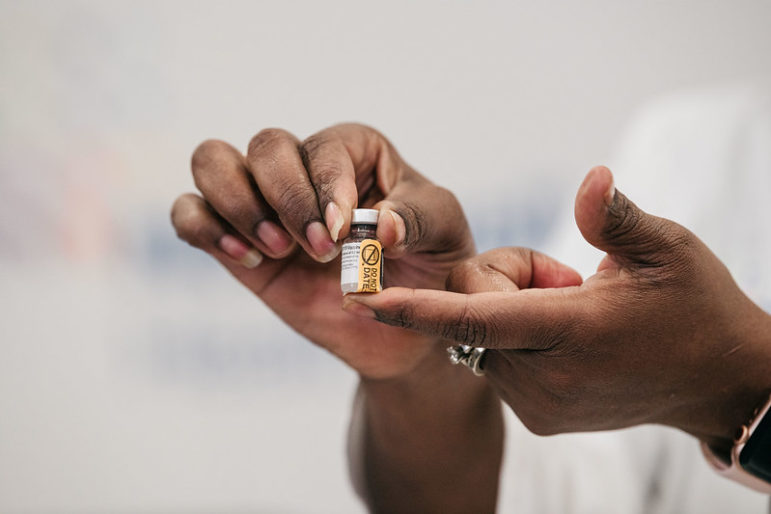‘To reach those currently experiencing homelessness, it is essential for organizations with longstanding visibility to be empowered and unrestricted to vaccinate in non-traditional settings. Imagine a popup clinic under the GW Bridge, inside Port Authority or inside the MTA terminals at Barclay Center or Grand Central.‘

Scott Heins for the Office of Governor Andrew M. Cuomo
The first coronavirus vaccine in New York State, administered to a healthcare worker last week.A full year into the coronavirus pandemic and there is finally light at the end of the tunnel. According to the Biden administration, America will produce enough vaccines to inoculate every adult by the end of May – weeks ahead of initial projections.
But just having the vaccines is half the battle. Getting these potentially life-saving doses into the arms of the most vulnerable among us – especially our homeless and formerly homeless neighbors – is an imperative. It is critical that we succeed in order to protect our entire community from the virus.
Vaccinations are obviously the answer. The best answer for vaccinating the homeless, and those with hesitancy, are one-dose shots like the one created by Johnson & Johnson. Some scholars suggest that while most private clinics have a no-show appointment rate of 5 percent, those that primarily help low-income and homeless people experience missed appointment rates as high as 50 percent. Such data vividly shows we must be imaginative in our approach to vaccinate all New Yorkers.
My organization, Project FIND, has already started vaccinating homeless persons and formerly homeless residents via onsite vaccination events held at our supportive housing sites, in partnership with local pharmacies. Some of my supportive housing colleagues are doing the same. But no one organization alone can tackle this immense task. We need a coordinated effort across New York State to prioritize the homeless and formerly homeless residents who have been some of the hardest hit by the virus.
The pandemic took a disproportionate toll on all low-income New Yorkers of color, but it has been particularly acute for the homeless, creating what some experts have deemed a “crisis within a crisis.” Though homeless individuals are especially vulnerable to catching COVID-19, as they have no safe, independent housing in which to shelter, they are being left behind by vaccination efforts. Recently released zip code data showed that the percentage of New York City residents who have been inoculated is significantly higher in wealthier and predominantly white neighborhoods.
 CityViews are readers’ opinions, not those of City Limits. Add your voice today!
CityViews are readers’ opinions, not those of City Limits. Add your voice today!
Vaccinating individuals touched by homelessness is an issue of racial justice. The vast majority of homeless people, as well as the formerly homeless tenants of supportive housing, are Black and Brown New Yorkers.
Some impoverished or homeless people of color have a valid distrust of government efforts – even when they are designed to help, not hurt. The trauma of institutionalized racism and profit-driven, hegemonic healthcare policies keep many disconnected from preventative healthcare, unless it is good for billing. Tupac Shakur and Tim Roth comedically touch on this subject in the 1997 film “Gridlock’d,” where one character tries to intentionally stab another just to get access to overdose medications.
We must be smart and strategic about how and where we establish vaccination sites to reach those detached from mainstream healthcare. Translated into Black Church and social work language, “We must meet people where they are.”
To do this, vaccines must literally hit the streets.
To reach those currently experiencing homelessness, it is essential for organizations with longstanding visibility to be empowered and unrestricted to vaccinate in non-traditional settings. Imagine a popup clinic under the GW Bridge, inside Port Authority or inside the MTA terminals at Barclay Center or Grand Central. After all, these are New Yorkers without fixed addresses and reliable broadband access to set appointments at The Jacob Javits Center or Yankee Stadium.
We should start by increasing pop-up clinics at single-site supportive housing buildings. Taking the vaccine directly to where people live and hang out leverages the relationships they have with the on-site staff who know these individuals best. This structure helps combat misinformation – and it works. One of our partners reported that vaccination rates tripled when they opened on-site clinics. That is because the staff involved are dedicated human service workers who were there during the darkest days of the pandemic, building the foundation of trust necessary for a far-reaching public health initiative to succeed.
This approach, coupled with the ease of the one-shot Johnson & Johnson vaccine that does not require the difficulty of follow-up visits, is our best chance to overcome one of the pandemic’s deep racial divides. Now that the majority of frontline essential workers, nursing home residents and the elderly have been vaccinated, we have a moral imperative to ensure that the most vulnerable are protected. We can do so – we just have to follow a formula that works.
Mark Jennings is the associate executive director of Project FIND, which provides low- and moderate-income and homeless seniors with services and support to live independently.









One thought on “Opinion: To Reach New York’s Most Vulnerable, Vaccines Must Literally ‘Hit the Streets’”
A solid article with keen insight into a major issue that needs to be addressed. Following the suggestions of Mark Jennings, the author of the article, will go a long, long way in bringing safety and well being to so many who would otherwise be overlooked and therefore neglected. Jennings has a handle on the realities of it all!